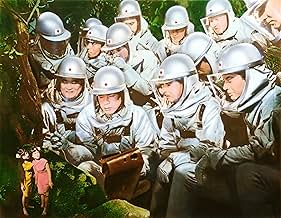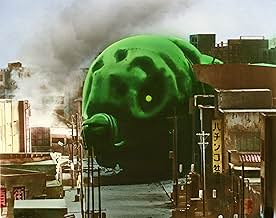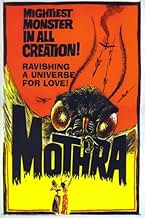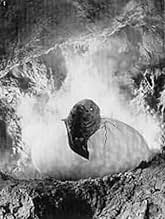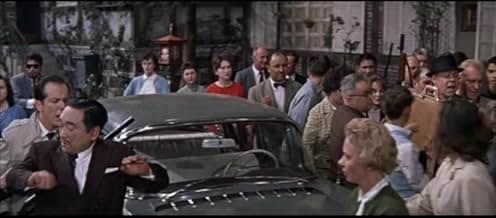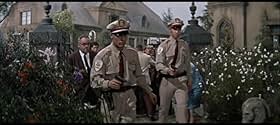Uma expedição à Ilha Infante descobre uma população indígena e pequenas fadas que adoram a divindade mítica da ilha. Conhecido como Mothra, ele vai em resgate de suas fadas quando elas são s... Ler tudoUma expedição à Ilha Infante descobre uma população indígena e pequenas fadas que adoram a divindade mítica da ilha. Conhecido como Mothra, ele vai em resgate de suas fadas quando elas são seqüestradas por um homem de negócios ganancioso.Uma expedição à Ilha Infante descobre uma população indígena e pequenas fadas que adoram a divindade mítica da ilha. Conhecido como Mothra, ele vai em resgate de suas fadas quando elas são seqüestradas por um homem de negócios ganancioso.
- Direção
- Roteiristas
- Artistas
- Prêmios
- 2 indicações no total
- Shobijin (Twin Fairy)
- (as Yumi Ito)
- Shobijin (Twin Fairy)
- (as Emi Ito)
- Kurâruku Neruson
- (as Jerî Itô)
- Military Advisor
- (as Yoshibumi Tajima)
- Nelson's Henchman
- (as Hiroshi Iwamoto)
- Ship Survivor
- (cenas deletadas)
Avaliações em destaque
1961's Mothra runs pretty evenly, allowing the story to breathe adequately before dishing out some modest mass destruction. The film's first acts, with scientists exploring Infant Island, remind me greatly of Skull Island from King Kong; the manner in which they use the fairies as a sideshow is not too far off from Kong either, only instead of unleashing a giant monkey's wrath, the fairies sing and summon a giant larva. It's weird stuff, but the film plays everything out with a straight face. This film ultimately sets the pattern for future incarnations of Mothra (you seriously can't have Mothra without the singing fairies, the larva, or without specific phases of attacks). As the original feature, however, the only formula this film adheres to is that of the classic monster picture, with a bit of adventure thrown in, and it's neat that way.
The story's pretty much outlined above; it is a well-structured plot with a cast of alright (and sometimes goofy) characters. With all the fairies and monsters on display, I always felt that Mothra was a grade more unbelievable than most other monster movies, but thanks to the film's earnest tone, it works as a fine and dandy fantasy (and it's pretty neat to see such fantasy being opposed by modern and ultramodern weaponry). The story touches upon a few themes concerning capitalism and greed, but is never overbearing.
This film uses solid, quality photography and editing. Acting is good from the original cast (but might be marred heavily by the English dubbing if you chose to watch it). Writing gets the job done pretty well. This production shows its age, but still uses fine-looking sets, props, and costumes. Special effects are a bit rough, but for its time, they are smashing. Music is not bad either.
No matter how silly or fantastic it gets, I have a soft spot for Mothra, especially in seeing her future clashes with Godzilla and other monsters. The first and most original Mothra film presents the basics of Mothra-lore, which in turn echoes parts of the original King Kong, and would stand proudly next to classic monster flicks like Godzilla. Fans of the genre should give this original film a rent.
4/5 (Entertainment: Good | Story: Pretty Good | Film: Good)
A greedy showman/explorer Clark Nelson (Jerry Ito) finds twin fairies on an island off Japan. He displays them on the Tokyo stage, where they sing what sounds like a lullaby. It is actually a telepathic distress call to their god and protector, Mothra, a giant caterpillar. Mothra comes to Tokyo, searching for the girls and Nelson, destroying most of the city in it's path. The chase goes from Tokyo to Newkirk City (I guess this is suppose to be a little real life hamlet just south of Yonkers!) What I really love about MOTHRA is that it has many things most other monster movies don't. The hero is a comical, older, tubby reporter, a sort of Japanese Lou Costello. The monster is actually pretty. In the Japanese version, there is some wonderful slapstick and odd humor. THese elements make this film so unique. Director Inoshiro Honda was best friends with more famous and more respected Japanese director Akira Kurosawa. Kurosawa loved Honda's monster movies and according to rumor, yearned to make one himself.
Unlike the other monsters, Mothra can die, and has done so. But it continues to protect its people by reproducing the old fashioned way--it lays eggs. IT is also intelligent and intuitive, and its nature is NOT aggressive or violent. It's almost Buddhist in nature.
The only other time they tried to work this kind of mysticism into these movies was with King Cesar--a giant cocker spaniel with contacts. The beast was just too goofy to be taken seriously.
Mothra is a great addition to the canon.
If the original Godzilla was the '50s classic kaijyu movie, this is that of the '60s, spawning many movies that follows featuring Mothra.
This movie was created on the following year Japan signed the "Treaty of mutual cooperation and security between Japan and U.S." of 1960 and reflects the politically charged atmosphere against US at the time in Japan. For instance, country Rorisika is a combined name of Russia, and America (in the original novel, the name was even more obvious Russirica, but was changed for the world wide release of the movie), and New Kirk city is an obvious synonym for New York city. US and Russia by the way were the only countries in the world performing hydrogen bomb experiments at the time, and No. 2 Genyomaru's, encounter with the test was also a hidden criticism against these experiments.
In the original novel, the location where Mothra spews the cocoon is the parliament building, but this was viewed as a political statement against the said treaty, and was changed to Tokyo tower. The movie features a real life twins The Peanuts (Emi and Yumi Eto) who were popular singers in Japan at the time. The Mothra song they sang were written by Tomoyuki Tanaka, Ishiro Honda, and Shinichi Sekizawa first in Japanese, and Indonesian student residing in Japan at the time translated it into his language. The original manuscript of this handwritten song is now displayed in Yuji Koseki (who was the composer for this song) museum in Fukushima city Japan.
The plot and special effects are tour de force. One of Mothra's lava costumes had 8 men in it with Godzilla suit actor Haruo Nakajima taking the lead. Mothra is the first kaijyu that's not just out for destruction, but is a protector of the environment. When the Mothra lava spews silk, it really looks real. The silk was made from rubber contact cement thinned down with solvent and shot out of Mothra's mouth using air brush. Actor Hiroshi Koizumi reprises his role as Shinichi Chujyo in 2003 movie Godzilla vs Mecha Godzilla Tokyo SOS after 42 years this movie was made.
Still after half a century, this is one of the best kaijyu movie ever created.
Você sabia?
- CuriosidadesThe Mothra larva was the largest costume Toho would create in the Showa era. The Mothra larva seen rampaging through Tokyo's neighborhood was about 7 feet tall and just over 31 feet long. Weighing about 265 pounds (120 kilograms), a total of eight actors were needed to perform and operate the Mothra larva.
- Erros de gravaçãoWhen Dr. Shinichi is showing the symbols he discovered in the cave to Senchan, you can see someone in black pants and shoes walking down the stairs behind Senchan's head.
- Citações
[the protagonists confront Nelson to return Mothra's fairies back to Infant Island]
Dr. Shinichi Chujo: I want you to stop this inhumanity and return them to their island.
Nelson's Henchman: Inhumanity? Ridiculous. Strictly speaking they're just scientific data.
Clark Nelson: Those fairies aren't human. They're merchandise.
- Cenas durante ou pós-créditosIn the credits for the U.S. version, including promo material released by Columbia Pictures, Eurasian model Jerry Ito (who plays the villianous Mr. Nelson) is billed as "Jelly Ito."
- Versões alternativasThe American Version also edited the birth of Mothra sequence, cutting out a good 40 seconds to make it more elaborate
- ConexõesEdited into A Guerra dos Monstros (1965)
Principais escolhas
Detalhes
Bilheteria
- Faturamento bruto mundial
- US$ 90
- Tempo de duração1 hora 41 minutos
- Mixagem de som
- Proporção
- 2.35 : 1
Contribua para esta página




